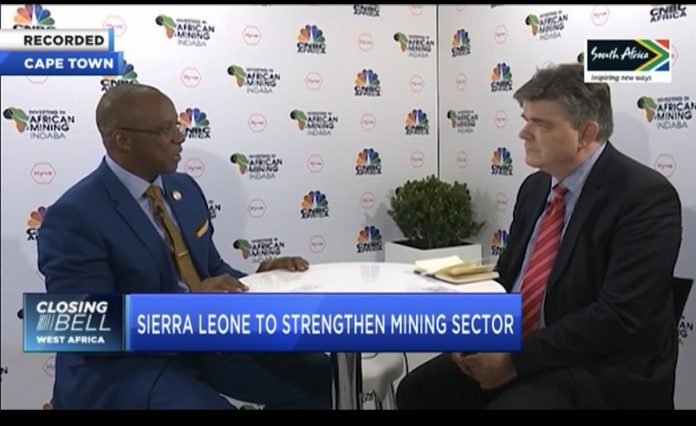By Amin Kef Sesay
In a bid to attract investors to the mining sector in the Sierra Leone, the Director General of the National Minerals Agency (NMA) Julius Mattai during an interview with CNBC Africa’s Chris Bishop on the sidelines of the Africa Mining Indaba in Cape Town, South Africa, he assured investors of plans and efforts to strengthen its mining sector in the country.
Speaking during the interview, Julius Daniel Mattai, stated that in January 2019 the country took a nationwide airborne Geophysical Survey that was geared towards providing reliable geo-data which will help determine the minerals within Sierra Leone in the most comprehensive way ever and put the country on a sound footing to bargain from a position of strength with potential investors and hence optimize the benefits of exploration and exploitation of the country’s mineral wealth.
He disclosed that the survey was done by contractors of Xcalibur Company, a South Africa/ Spanish firm which he said was one of the best surveys done as they flew over a half million kilometers using two sensor magnates and radiometers covering the country’s entire two thousand square kilometres. He noted that they collected high quality data which they are currently processing adding that the data processing and interpretation is ongoing and the final data set will be out by March this year.
He said with this result he firmly believes that it will reduce the cost on mining companies as they spend a lot of money during their exploration stages, adding that for the first time the country will be able to know were minerals are disclosing that they also intend to undertake Geochemical and Geological surveys to ensure that Sierra Leone has a complete knowledge of minerals in the country and making that available to the general public and on their website which they are preparing currently to enhance easy access by mining investors without coming to Sierra Leone.
Underscoring the plans taken so far in order to strengthen the mining sector he said the country is reviewing the Mines and Minerals Act of 2009 which will create the platform for better investments in the mining sector.
“We have the Mining and Mineral Operational Regulations which will not only open the space for investors but strengthen the mining sector,” he underscored.
He called on investors to come join hands together in order to interpret the data with the firm belief that Sierra Leone will be the new destination for mining. The NMA boss further stated that with good regulatory and legislative frameworks investors are assured of guidance and protection of their investments in the country.
Julius Mattai said that technology will maximize benefits from mining as their focus is about optimizing growth and investment in a digitalized mining economy, adding that one of the key focus of the New Direction is human capital development and in that regard the country has minerals but how they can transform those minerals to social capital in order to benefit the people of Sierra Leone and investors is very important.
He ended by saying that they are undertaking a nationwide consultation with stakeholders, development partners, local communities and to ratify where there are disagreements in order to ensure that the investment of investors are protected.
Sierra Leone’s government has deployed mine monitors and is considering using drones to try and stop the smuggling of diamonds and gold across its borders into neighbouring Liberia and Guinea.
“We are taking very stringent measures,” said Julius Mattai, furthering how “There has been a massive reduction in smuggling. An estimated 300 000 to 500 000 people work as artisanal miners in the West African nation. Mining in Sierra Leone was on the up in May 2014 – exporting billions of dollar a year of iron ore alone until Ebola struck. In just over 18 months the industry was devastated; workers died from the disease, exports were over and those who survived fled the country taking their mining skills with them he narrated.
Nearly five years on, the young Director General of NMA is helping to bring the industry back to life. Julius Mattai’s eyes lit up when he talked about the prospects for his country’s mining industry on his mission to find foreign investors at the Mining Indaba 2020.
“We can double the size of our mining industry by 2025,” he said with genuine pride and enthusiasm.
He revealed how such an inspiration has come from above. The Government has just completed an aerial survey of the country’s mineral wealth and the results, to be released next month, look good at first sight.
“They show that Sierra Leone has a healthy stock of platinum group metals, rutile – a prized and pricy titanium dioxide that is used in aerospace and pigmentation. There is also an abundance of Coltan used to bind together the inside of laptops along with gold, diamond, bauxite and chromite,” he maintained furthering that “We want to make Sierra Leone a flagship of Africa mining,” says Mattai.
“Changes in Government mining rules have prompted 15 mining companies to come back to Sierra Leone out of which four are operational. In 2019, mining in Sierra Leone increased an export base of $350 million and employed 7,000 people,” he disclosed affirming, “We want to create the right business environment,” says Mattai.
According to him Sierra Leone suffers like many African mining nations from a dearth of skills and power but at the very least it is trying to open the door to investors in the hope of a rapid revival and all the wealth and employment minerals bring. Other African mining nations could learn from that.






